|
The Frankish Kingdom
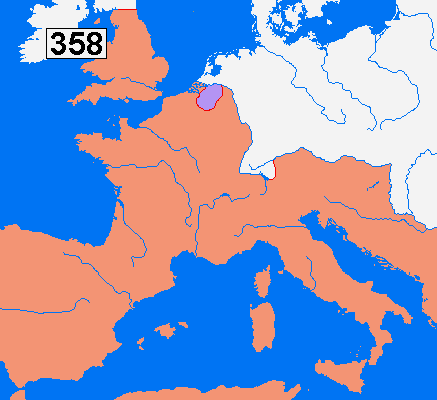
 = Roman Empire
= Roman Empire
 = Frankish foederati
= Frankish foederati
The Franks were originally a confederation of Germanic tribes east of the
Rhine that from AD 257 began to raid Roman territory. Because they were
just one of several Germanic tribal confederations that ravaged the
Roman Empire from the third century and onwards the Roman emperors had great
difficulties to ward of their attacks. Not even the seas were safe from
Frankish attacks since they also were capable pirates. But the Franks
also had a positive influence on Rome by supplying many recruits to the
Roman army and a Frankish tribe got permission by the emperor
Julian to settle on Roman territory between the rivers Schelde and Meuse
as foederati (ally) in AD 358. As foederati the Franks were obliged to assist the
Roman Empire with troops but got in return complete autonomy in the area
where they were settled. Thereby a Frankish state had been created that a
few centuries later would dominate western Europe.
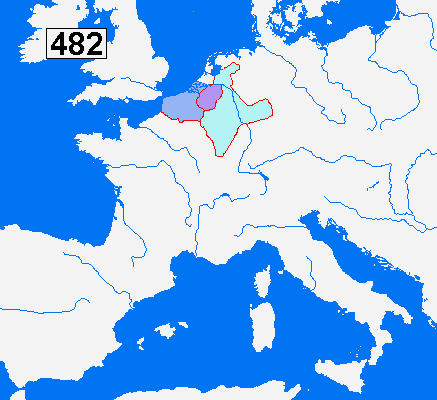
 = Salian Franks 358
= Salian Franks 358
 = Conquests to 460
= Conquests to 460
 = Conquests to 482
= Conquests to 482
The Salian Franks was not the only Frankish tribe that settled on Roman
territory. In about AD 430 Franks were allowed to settle in the area west of
the Salian Franks' original territory and from the east of the Rhine came those
Franks which have been called Ripuarians by the historians and who took possession
of the area between the rivers Meuse and Rhine. Those Franks who remained in the
Franks’ original territory east of the Rhine were called Eastern Franks.
The leading Frankish tribe was the Salians and their kings united all
Franks during the latter half of the fifth century. These kings were called
Merovingians because they descended from Merovech whom the Franks believed
to be son of a divine creature.
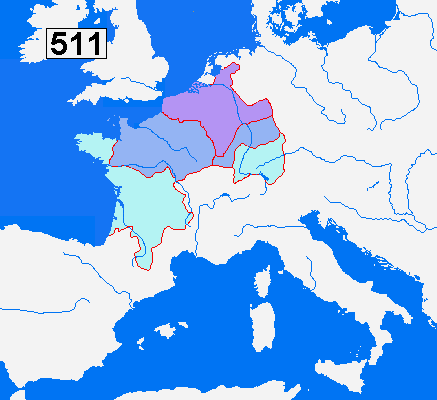
 = Frankish Kingdom 482
= Frankish Kingdom 482
 = Conquests to 496
= Conquests to 496
 = Conquests to 507
= Conquests to 507
The most famous Merovingian king was
Clovis who ascended the throne about 482 AD. He was already from the
beginning of his reign forced to fight rivalling Frankish leaders whom he
brutally killed. The last remnant of the West Roman Empire was conquered in
486 when Clovis defeated Syagrius who had ruled over northern Gaul. That
part of the Frankish kingdom would be called Neustria (the New Land) as
opposed to Austrasia (the Eastern Land), which was the original core
territory of the Franks. Clovis’ conquests were however far from over and
he attacked and defeated the Germanic tribal confederation of the Alemanni
in about 496 AD thus adding large territories to his realm. The
influence from his Burgundian queen Clotilda persuaded him to convert to
Christianity after the battle against the Alemanni. Clovis’s decision to
join the Catholic church rather than the Arian branch of Christianity like
the other Germanic peoples had great significance since he then could
count on support from the population in his neighbouring kingdoms who
regarded the Arians as heretics.
The struggle against the Alemanni
was however not over until 502 when all their territory was conquered by
the Franks, except for a minor area that was protected by the Ostrogoths.
Before that Brittany had been forced into submission although they
retained considerable autonomy. Clovis’ last conquest was Aquitaine, which
was taken from the Visigoths in 507. Only an intervention from the Ostrogoths
prevented a complete conquest of the Visigoth kingdom. That campaign also
resulted in Clovis’s appointment to Roman Consul by the East Roman
emperor, which increased the prestige of the Frankish kingdom and gave
their claim to be an heir to the Roman Empire greater credibility.
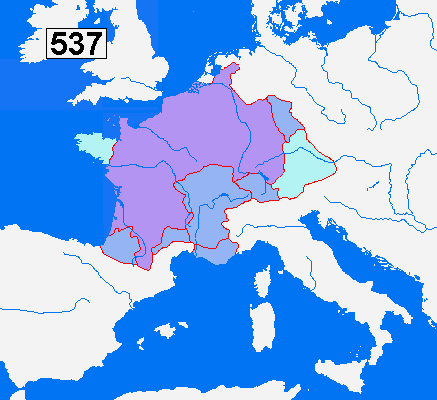
 = Frankish Kingdom 511
= Frankish Kingdom 511  = Conquests to 537
= Conquests to 537
 = Vassal states
= Vassal states
When Clovis died in 511 the kingdom was divided between his four sons. This
followed a pattern that would be repeated during the following centuries
and meant that the Frankish kingdom was only united during short periods.
The Merovingian kings were however very belligerent and many of them died
before they had spawn any sons, which prevented the kingdom from being
permanently dissolved. But a consequence of the divisions was that the
Merovingians in an increasing extent fought more among themselves than
with external enemies. An exception was the period 531-537 when the
Frankish kingdom again conquered vast territories. The Thuringian kingdom
was destroyed and a part of it was conquered 531. The Burgundian kingdom was
conquered 532-534 and as a result of the East Roman emperor’s war against
the Ostrogoths the latter was forced to cede what remained of Alemannia
together with Provence to the Frankish kingdom 536-537 in exchange for
Frankish neutrality. At the same time Bavaria was forced to recognise
Frankish supremacy and the Frankish kingdom strengthened its control over
Aquitaine.
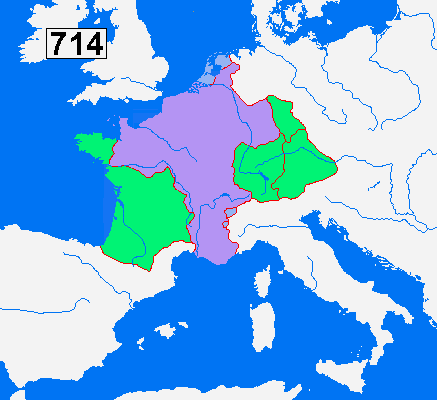
 = Frankish kingdom
= Frankish kingdom  = Conquests
= Conquests
 = Losses
= Losses
The continuous divisions of the kingdom between the Merovingians had the
effect that three Frankish part kingdoms came into being, Neustria in the
west, Austrasia in the east and Burgundy in the south. The peripheral
areas like Brittany, Aquitaine, Alemannia, Thuringia and Bavaria often
tried to gain independence and the repeated struggles between the
Merovingians gave them several opportunities to do so. The Thuringians became
independent after the death of Dagobert I in 639. Aquitaine refused to
acknowledge the Merovingians' rule after the murder of Childeric II in 675.
The already autonomous states of Brittany and Bavaria freed themselves
from the Franks during the latter half of the seventh century. Finally
Alemannia managed to gain its independence 709-712. The conquests that
were made during the same period could not compensate these losses. A few
areas in the Alps had been conquered from the Lombards in 575 and western
Friesland was subjugated in 689. But the Frisians made just like the other
peripheral areas several attempts to regain their freedom.
The Merovingian kings did not only lose territory during this period,
their power in the remaining parts of the Frankish kingdom were also
reduced as a result of under aged kings. The office of Major Domus had
been created to manage the kingdom until they came of age, but since it
became permanent and hereditary the holders of these offices became the
real rulers of the Frankish kingdom even when the kings were adults. In
the battle at Tertry in 687 the Major Domus of Neustria and Burgundy
was defeated by his Austrasian colleague Pepin of Heristal who thereafter ruled
the entire Frankish kingdom.
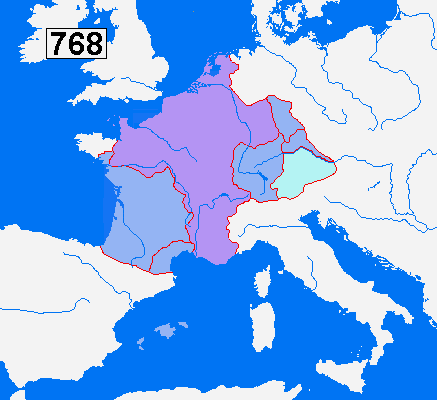
 = Frankish kingdom 714
= Frankish kingdom 714  = Conquests to 768
= Conquests to 768
 = Vassal state
= Vassal state
When Pepin of Heristal died in 714
his six year old grandson Theudoald became the new Major Domus. The office
that had been created to manage the kingdom when the kings were minors had
now grown to be so powerful that it self could be inherited by minors.
Pepin’s illegitimate son Charles Martel however did not accept this
transition of power and proclaimed himself Major Domus and became the
first ruler of the Carolingian dynasty, which definitely deprived the
Merovingians of their power. The following decades were almost without
interruptions spent on wars when the Carolingians tried to reconquer the
lost territories and ward of attacks from the Arabs, whose invasion in 732
was repulsed in the battle at Poitiers. The struggles to unify the kingdom
were hard but successful. Thuringia, Alemannia and Bavaria were finally
subjugated in 744. Bavaria retained their old autonomy but ceded all land
north of the Danube. The Franks took control over the Balearic islands in 754
and conquered Septimania from the Arabs in 759. Aquitaine was reconquered in
768. An alliance with the pope led to two successful campaign against the
Lombards 754 and 756. At the same time the Carolingians strengthened their
power within the Frankish kingdom and Pepin the Short deposed the last
Merovingian king in 751 and had himself elected king.
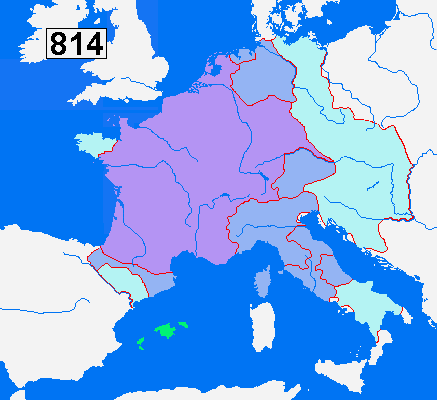
 = Frankish Kingdom 768
= Frankish Kingdom 768
 = Conquests to 814
= Conquests to 814  = Losses 798
= Losses 798
 = Loosely held territories
= Loosely held territories
Pepin the Short died in 768 and left
Western Europe’s strongest kingdom to his two sons Charlemagne and
Carloman. The latter died 771 and Charlemagne could use the resources
of the unified kingdom to expand it in all directions. When the Lombards
threatened the Pope again, Charlemagne invaded Italy and made himself king
of the Lombards 774. The Lombard principality of Benevonto in southern
Italy would however only recognise Charlemagne’s supremacy for brief
periods. In contrast to the quick conquest of the Lombard kingdom, the
subjugation of the Saxons in the northeast (772-804) was a long and bloody
affair. To break the Saxons' will to resist, Charlemagne massacred thousands
of them and only through deportations of Saxons and resettling of Franks
and Slavs in their place was the region finally pacified. Bavaria, which
always had been an unreliable vassal, was annexed to the Frankish kingdom in 788
after its duke had conspired with Lombards and Avars. The Avar Empire with
its centre in Hungary was crushed 791-796 whereupon the Slavic areas in
Central Europe recognised Charlemagne’s supremacy. Eastern Friesland was
conquered 784-785 and Brittany acknowledged Frankish supremacy 799. The
campaigns against the Arabs were less successful but Charlemagne managed
to extend his influence to the river Ebro 812, although the Arabs in their
turn had taken the Balearic Islands in 798.
The Conquests of Charlemagne were
so huge that people thought he had restored the West Roman Empire. A
consequence of that was Charlemagne’s coronation to emperor by the pope in
800. But the Frankish tradition to divide the kingdom between the kings’
sons made the unity only temporary. The Frankish kingdom was also a feudal
state that was held together by lucrative wars of plunder in the
neighbouring countries. When the kingdom expanded its territory, the
prospects of lucrative plundering decreased and with that also the loyalty
of the nobility when they no longer could expect to be richly
rewarded for their services. Because of this the Frankish Empire would after the
death of Charlemagne in 814 disintegrate under both internal and external pressure
into several different kingdoms, which in their turn were divided into
numerous petty feudal states.
Read about the dissolution of the Frankish Empire
on this page.
List of Frankish kings |

